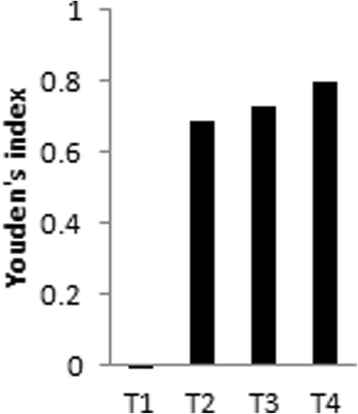Performance evaluation of existing immunoassays for Clonorchis sinensis infection in China
- PMID: 29334990
- PMCID: PMC5769360
- DOI: 10.1186/s13071-018-2612-3
Performance evaluation of existing immunoassays for Clonorchis sinensis infection in China
Abstract
Background: Clonorchiasis ranks among the most important food-borne parasitic diseases in China. However, due to low compliance to traditional fecal examination techniques in the general population and medical personnel, immunodiagnosis is expected. This study evaluated, in parallel, the performance of four immunodiagnostic kits detecting clonorchiasis in China.
Results: A bank with 475 sera was established in this study. Except for the low performance of the kit detecting IgM, the other three kits detecting IgG showed sensitivities ranging from 81.51% (194/238) to 99.16% (236/238). Higher sensitivity was presented in heavy infection intensity [89.47% (68/76) to 100% (76/76)]. Among the four kits, the overall specificity varied from 73.42% (174/237) to 87.34% (207/237). It was observed that the specificity was lower in the sera of the participants living in clonorchiasis-endemic areas but without any parasite infection [67.5% (81/120) to 90% (108/120)], as compared to those from the non-endemic area [94% (47/50) to 98% (49/50)]. The cross-reaction rate varied from 14.93% (10/67) to 31.34% (21/67). Youden's index was -0.022, 0.689, 0.726, and 0.802 for kits T1, T2, T3 and T4, respectively. Repeatability was high in all four kits.
Conclusions: Three immunodiagnosis kits targeting IgG antibody had high performance on detecting chronic Clonorchis sinensis infection, but that detecting IgM antibody had not. The kits detecting IgG antibody also showed high sensitivity in heavy infection intensity. Research on immunological diagnosis of clonorchiasis is expected to be strengthened to improve the sensitivity in light infection and specificity.
Keywords: Clonorchiasis; Clonorchis sinensis; Evaluation; Immunodiagnosis; Sensitivity; Specificity; Youden’s index.
Conflict of interest statement
Ethics approval and consent to participate
The experimental methods involving sera used in this study were in accordance with the approved guidelines and regulations of the Key Laboratory of Parasite and Vector Biology, Ministry of Health. The collection of sera and study protocol in the endemic area were embedded in a control pilot. Ethical clearance of this pilot had been granted approval by the Ethics Committee of the National Institute of Parasitic Diseases, Chinese Center for Disease Control and Prevention in Shanghai, China (permit number 2011-005). The objectives, procedures, and potential risks were orally explained to all participants. A written consent form was also obtained from each participant with the participant’s signature or that of a proxy.
Consent for publication
Not applicable.
Competing interests
The authors declare that they have no competing interests.
Publisher’s Note
Springer Nature remains neutral with regard to jurisdictional claims in published maps and institutional affiliations.
Similar articles
-
Serological diagnosis of clonorchiasis: using a recombinant propeptide of cathepsin L proteinase from Clonorchis sinensis as a candidate antigen.Parasitol Res. 2012 Jun;110(6):2197-203. doi: 10.1007/s00436-011-2749-x. Epub 2011 Dec 16. Parasitol Res. 2012. PMID: 22173451
-
Clinical Value of IgG Antibody Test in Screening for Clonorchis sinensis Infection in High-Risk Population.Clin Lab. 2024 Nov 1;70(11). doi: 10.7754/Clin.Lab.2024.240430. Clin Lab. 2024. PMID: 39506592
-
Clonorchis sinensis: glutathione S-transferase as a serodiagnostic antigen for detecting IgG and IgE antibodies.Exp Parasitol. 2002 Aug;101(4):231-3. doi: 10.1016/s0014-4894(02)00112-1. Exp Parasitol. 2002. PMID: 12594964
-
[Purification of Clonorchis sinensis native protein and their application in immunodiagnosis of clonorchiasis].Zhongguo Xue Xi Chong Bing Fang Zhi Za Zhi. 2011 Apr;23(2):221-4. Zhongguo Xue Xi Chong Bing Fang Zhi Za Zhi. 2011. PMID: 22164637 Review. Chinese.
-
Current status and perspectives of Clonorchis sinensis and clonorchiasis: epidemiology, pathogenesis, omics, prevention and control.Infect Dis Poverty. 2016 Jul 6;5(1):71. doi: 10.1186/s40249-016-0166-1. Infect Dis Poverty. 2016. PMID: 27384714 Free PMC article. Review.
Cited by
-
Human liver flukes in China and ASEAN: Time to fight together.PLoS Negl Trop Dis. 2019 Apr 25;13(4):e0007214. doi: 10.1371/journal.pntd.0007214. eCollection 2019 Apr. PLoS Negl Trop Dis. 2019. PMID: 31022171 Free PMC article. No abstract available.
-
Assessment of the application of the FA280-a fully automated fecal analyzer for diagnosing clonorchiasis: a mixed-method study.Infect Dis Poverty. 2025 Jan 6;14(1):1. doi: 10.1186/s40249-024-01271-8. Infect Dis Poverty. 2025. PMID: 39757228 Free PMC article.
-
Clonorchiasis or Paragonimiasis?Chin Med J (Engl). 2018 Mar 5;131(5):629-630. doi: 10.4103/0366-6999.226078. Chin Med J (Engl). 2018. PMID: 29483404 Free PMC article. No abstract available.
-
Current knowledge on the prevalence and detection techniques of Clonorchis sinensis in China.Front Vet Sci. 2025 Aug 13;12:1618633. doi: 10.3389/fvets.2025.1618633. eCollection 2025. Front Vet Sci. 2025. PMID: 40881629 Free PMC article. Review.
-
Clonorchiasis and opisthorchiasis: epidemiology, transmission, clinical features, morbidity, diagnosis, treatment, and control.Clin Microbiol Rev. 2024 Mar 14;37(1):e0000923. doi: 10.1128/cmr.00009-23. Epub 2024 Jan 3. Clin Microbiol Rev. 2024. PMID: 38169283 Free PMC article. Review.
References
Publication types
MeSH terms
Substances
Grants and funding
LinkOut - more resources
Full Text Sources
Other Literature Sources
Medical


